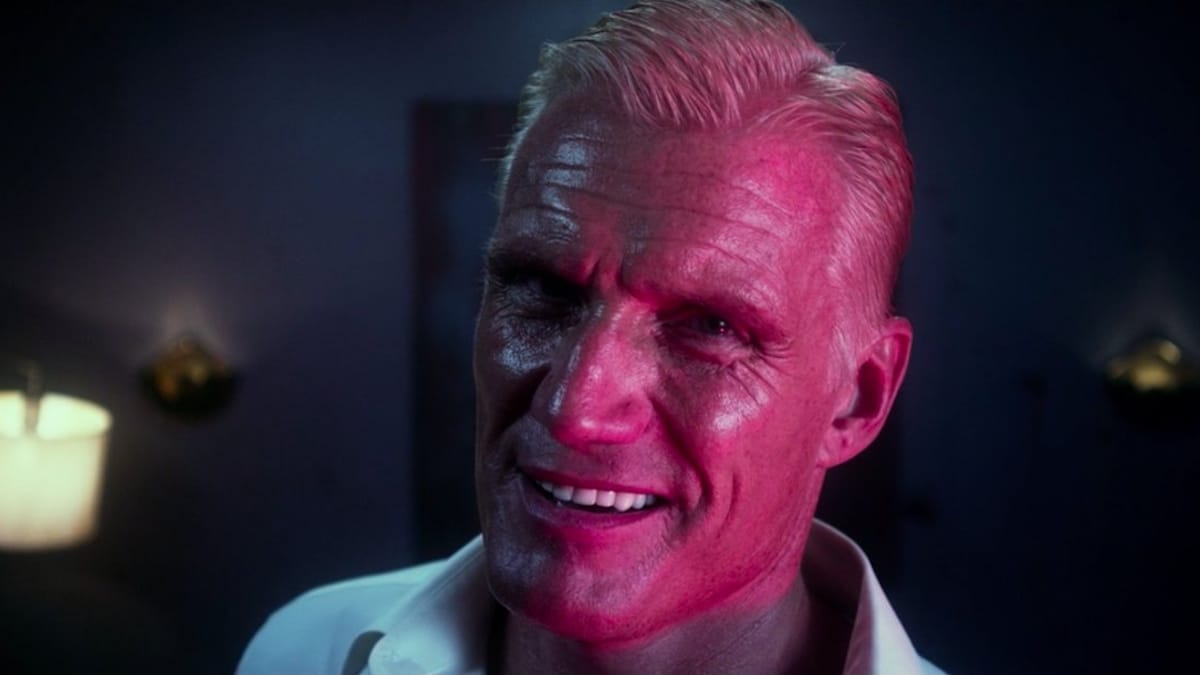On <i>Universal Soldier: Day of Reckoning</i>

The Lynchian, existential sequel celebrates its tenth anniversary
Already embedded within the concept at the heart of the Universal Soldier franchise is an acute bitterness about the American military’s treatment of the men who do its dirty work. In the first film, soldiers thrown into the meat grinder that is the Vietnam war have their inanimate corpses resurrected against their will into superstrong killing machines — the enraging irony in them getting reinforcements only once they’re dead is hard to miss. But then, they could not be stripped off their free will and reduced to obedient murderers whilst alive. Universal Soldier takes the hardened cynicism of First Blood and supercharges it via sci-fi.
There is, however, a less obvious corollary to this sociological reading, one that is haunting and sad in its own way. With their memories wiped, all the UniSols have left is their superhuman strength; they therefore exist on a more brutal and more sparsely populated plane of existence than the rest of us. Even those that do eventually recover snatches of their past and free will remain confined to a reality where their heightened physical power always seems to attract violence. They live in a world of pain where “hurt or be hurt” is the only rule — which also restricts them to a profoundly lonely existence.
One of the reasons Terminator 2: Judgment Day is so powerful is that it sees Arnie’s similar lonely robot find people who draw him out of this solitude. His enemy, the T-1000, is a lot scarier than the original model partly due to his speed and metallic appearance, both qualities that are bone-chilling on a visceral level. But this more advanced model also comes across as uniquely terrifying because its presence further underlines the utter loneliness of those cyborgs who live only for their mission: even seeing the T-2000, which is likely to be the only creature he has ever encountered that remotely resembles him, leaves the T-1000 cold. Universal Soldier (which some critics dismissed as a mere Terminator 2 rip-off) features a similar central dynamic between two UniSols, but the casting of two action stars of roughly similar calibre (Jean-Claude Van Damme and Dolph Lundgren) somewhat neutralises this grim undercurrent and lightens things up considerably.
John Hyams’ Universal Soldier: Day of Reckoning brings this existential dread back to the fore in a big way: its hero, Scott Adkins’ John, spends the entire film staring into the abyss, alone. Released in 2012 (straight-to-video in most territories) and made on a budget even smaller than its predecessor Universal Soldier: Regeneration, Reckoning has a plot so simple as to be primal. John wakes up from a coma in a strange room, suffering from amnesia, and is told that his wife and child were killed during a home invasion. It isn’t long before he decides to go on a deadly rampage, fuelled by a desire for revenge that only intensifies as snapshots of the incident return to his memory. His search, helped by tips from a helpful FBI agent working the case, soon puts him in the path of one, then several, UniSols determined to stop him.
The investigation itself, where each new discovery leads to more confusion, enemies emerge seemingly out of nowhere, and our hero only grows increasingly troubled about his own identity, lends the film a film noir structure that comes with its own atmosphere of anguish and distrust. But John hasn’t only lost his family: he has forgotten everything about them, save for the pain he felt when he saw them die. For him, the past is pure trauma, quite literally. This kind of extreme pain, inflated to such a surreal degree that the feeling itself becomes frightening, is familiar from the obsessive and nightmarish work of David Lynch, who is a clear inspiration here. There are obvious parallels: in Reckoning as in Twin Peaks and Lost Highway, a haunting and violent death triggers an existential identity crisis, which notably manifests itself through the appearance of various sets of clones. But Hyams also takes a few other, harder to reach pages from the Lynch book, notably in the ways he disturbs his film’s straightforward narrative and plays with the audience’s grasp on what they’re seeing.
Juxtaposed with John’s quest is an apparently separate storyline, which shows a UniSol called Magnus (Andrei Arlovski) enter a brothel and savagely murder everyone present, before he ultimately engages in a fight with Dolph Lundgren’s Andrew Scott (or rather, one of his clones; the “original” Scott died in the first film). Keeping dialogue to a minimum, Hyams drops his audience into these seemingly unrelated and unexplained moments without warning or guidance. He does, however, turn them into sequences so striking and uncanny that, spellbound, we no longer balk at the film’s mystery and instead lean into it quite willingly. 1
A world of shadows is pierced by neons; glistening under the lights are bodies that seem simultaneously very solid, and very finite. The effect is both touching and terrifying, particularly when said bodies are muscular and appear to be ultra resistant to punches, bullets and cuts. They are weapons wielded like heavy boulders, always seeking to cause maximum destruction, but so unencumbered by fear that they appear almost oblivious to the danger. Hyams and cinematographer Yaron Levy liberally play with speed to emphasise this sense of heaviness, which grounds the characters even as it makes them appear more dangerous and unstoppable than is realistic. The image slows down before a punch or fall then accelerates for the impact, as if the film itself was straining for the hit, and us together with it.
The result is absorbing also due to Hyams’ decision to rely on long takes that do not interrupt the fight choreography, designed by Larnell Stovall. Brutal, very close to the ground (in part due to an injury sustained by Adkins, whose high-flying 360 turning kick is a signature move) but always precise, the fights are both beautiful to look at and gritty, designed to emphasise actual impact more than acrobatic beauty. In an episode of Adkins’ own podcast The Art of Action, Hyams explains that this was in part inspired by the move known as ground-and-pound, which he’d observed when working on the MMA documentary The Smashing Machine (2002): “If someone was trying to kill another person, and was able to take them down and get in that position, repeated blows to the head would probably be the move.” This brutality is thrilling, but also shocking; it creates for the audience a tension that is sometimes sorely lacking in martial arts / action films: “I always want the violence to thrill the audience, but in the same way that the shark in Jaws thrills the audience.” We admire the moves of those martial artists, but through our fingers.
Many have described Reckoning as one of few films to could be classified as “action horror” due to the brutality and gore of its fight scenes, but the visceral on-screen violence also ties into the existential terror that runs through it like an icy undercurrent. Hyams takes his cue from Gaspar Noé, playing distended and repetitive sounds in the background of sequences otherwise devoid of music; the odd, pulsating kind of white noise is no doubt similar to what plays inside the heads of the UniSols, where their thoughts used to be. The effect is all the more hypnotic when those sound distortions work in tandem with the changing speed of the image. In one particularly striking, Dolph-centric sequence — which in fact resembles a seance of hypnosis — the seemingly uninterrupted flow of light from the neons in the room turns into strobing flashes as the image slows down. While the characters’ movements decelerate, our heart rates go up, our awareness sharpens.
In that context, the action — messy and raw, afflictive and out of control — also functions as cathartic release, both for John as he moves forward on his vengeance trail and for the audience. Though Reckoning is notable for being the closest thing to an arthouse action film we have, it has also gathered legions of fans because of how purely pleasurable and thrilling it is to watch. Hyams continuously juxtaposes moments of tension and release, in individual scenes and even within single movements, with unflinching attention to the way each decision impacts the complete body-and-mind experience of the viewer. Even the frustration felt at the beginning of the film, when John’s story appears to be going nowhere and Magnus seems utterly irrelevant, is by design: Hyams takes the risk of losing his audience early on because this uncertainty is what makes Reckoning’s conclusion that much more powerful. As John gets closer to his enemy and the pieces start to fall into place, the truth turns out to be so horrible that oblivion may feel like a preferable alternative.
Footnotes
- Justin Taylor put it brilliantly in a recent essay for Bookforum, writing about the novels of Cormac McCarthy: “As is so often the case with Lynch, there’s a non sequitur quality to this scene [...] in which an image is so powerful that its intensity becomes its own justification, destabilizing the basic conditions of the narrative even as the force of the disruption draws us deeper into the novel’s dreamworld.” back




